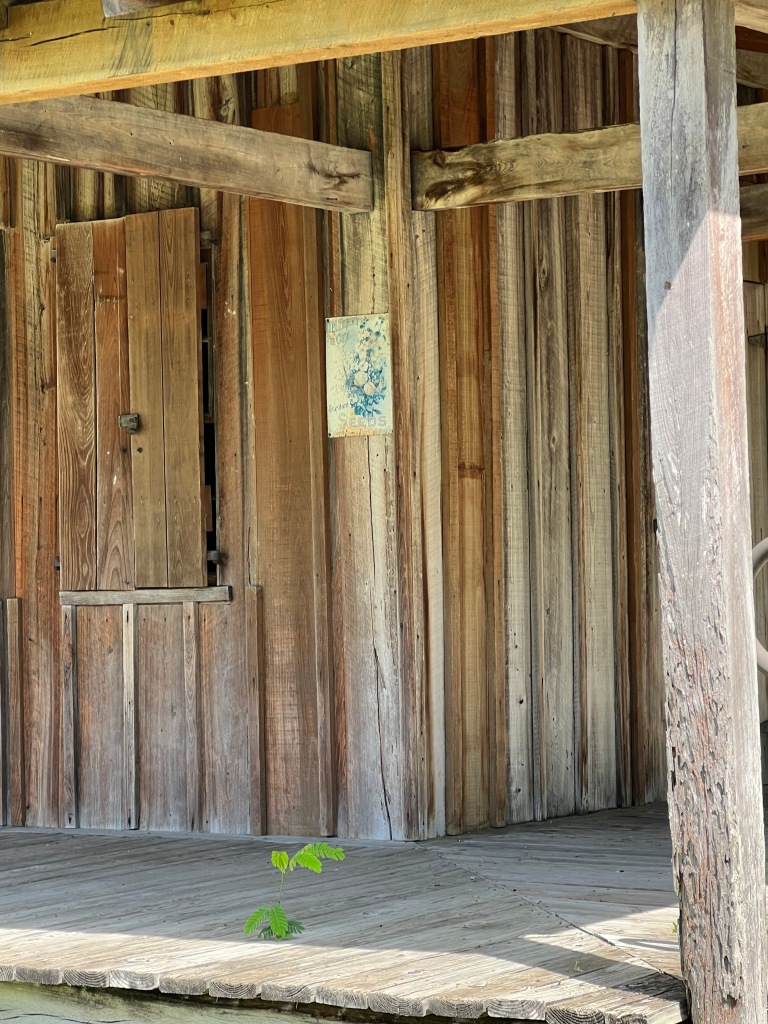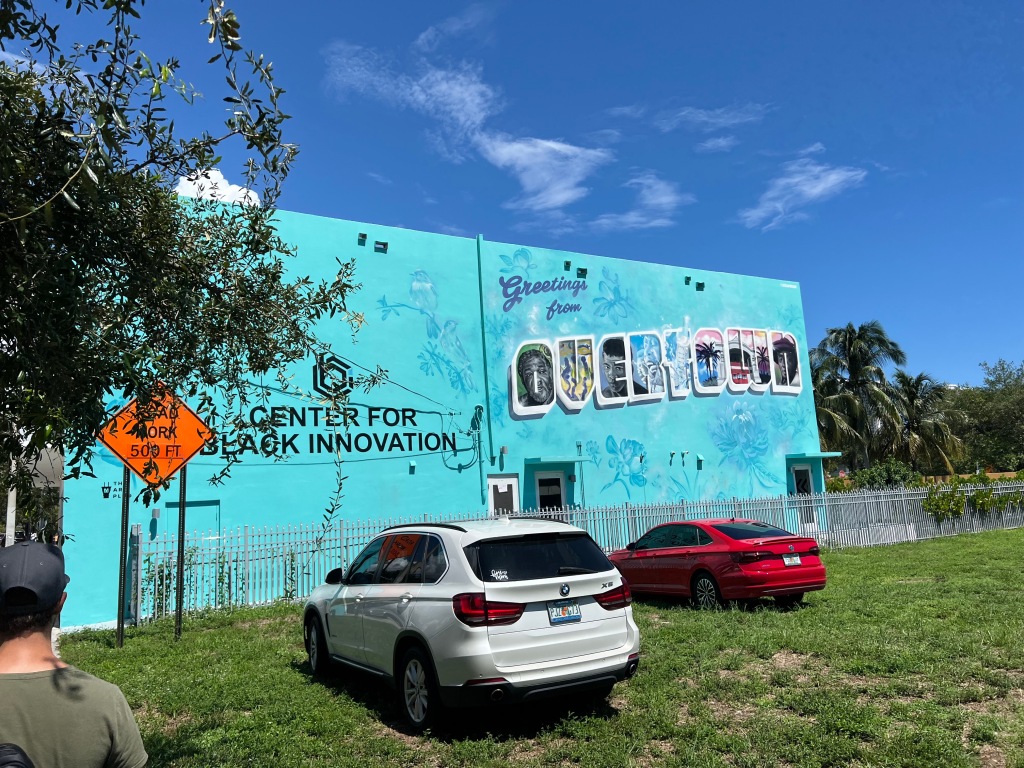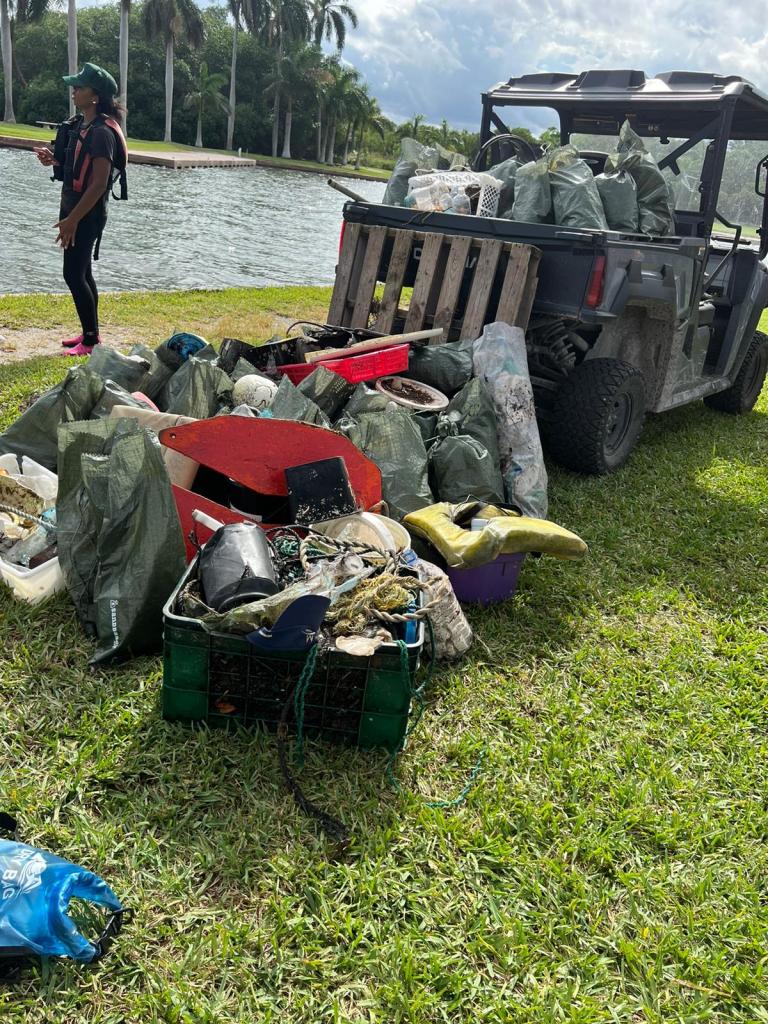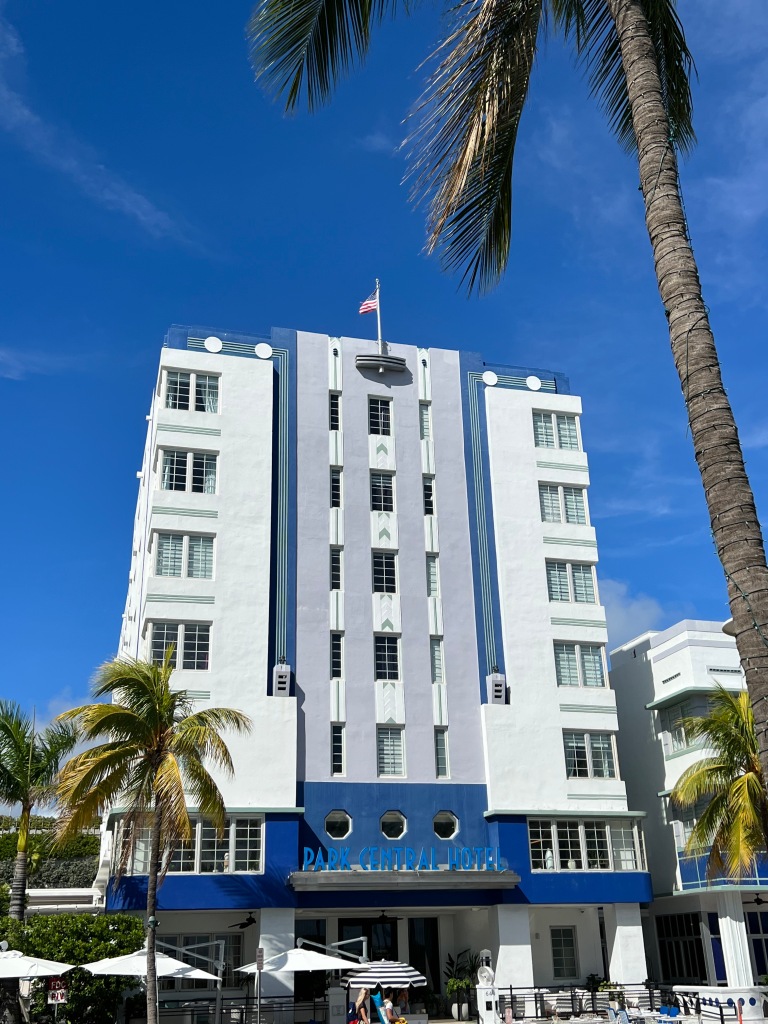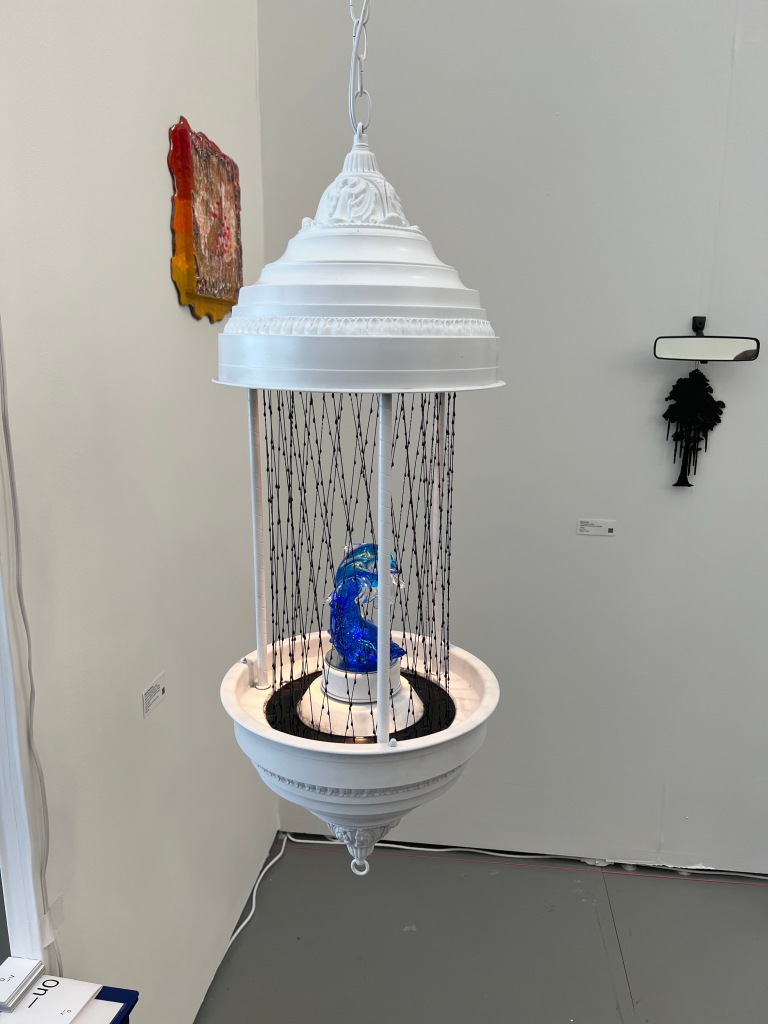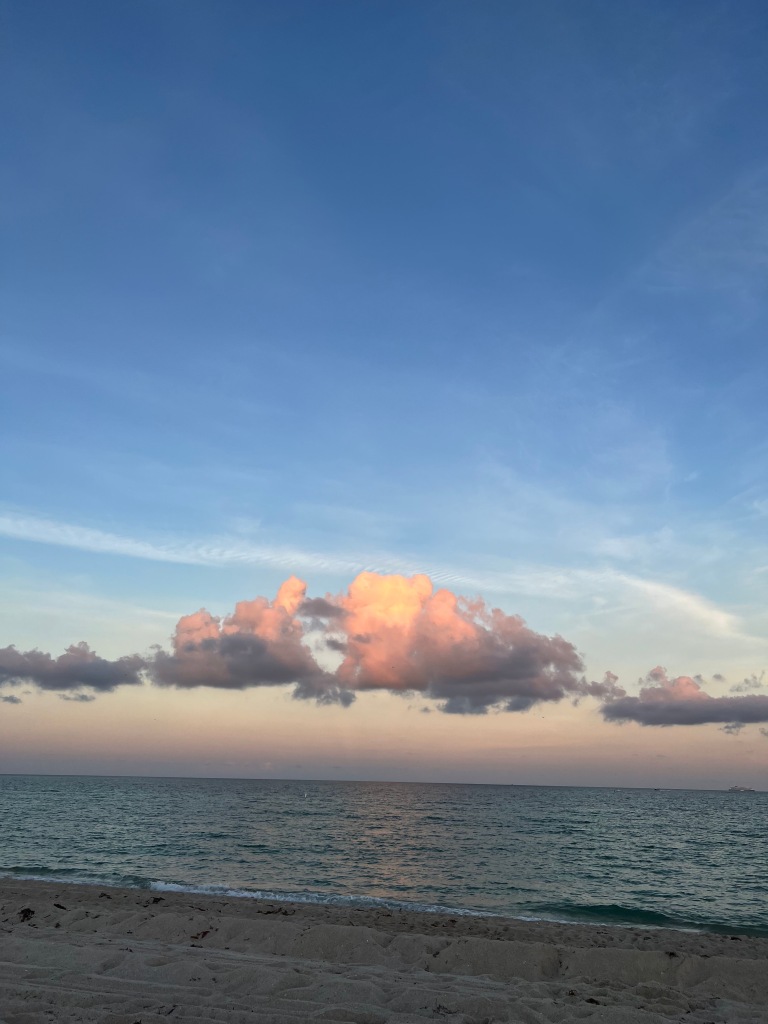
Miami Encounter as Text
“My Grand Abode” by Mariano S. Mendez Perez of FIU 2023
As a 10-year Miamian resident, I would say my time living here does not properly indicate my acquaintance of the place. The reason I say this is because apart from casual Downtown stroll or beach visit, I haven’t really gone anywhere else. There are two completely different timestamps regarding the before and after of taking Bailly’s Honors Class. The before, where I knew the most basic locations with little to no knowledge of Miami’s history, to now, the after, where I have visited incredibly beautiful settings, ones which have changed my perception of where I live.

I feel most individuals are just like I was one year ago, people who live in one of the most interesting locations in the world yet hardly know about it. The thing with Miami is that it has so much to offer, it is just massive. With an amazing guide like professor Bailly, one really gets to experience the true Miami. When I was looking for an Honors class, I was looking for another experience rather than a normal lecture and that’s exactly what I got. The locations are perfectly laid out, they offer extensive historical value and are overall exciting.
Although personally I see Miami as a futuristic and sensational city, throughout the course one gets to learn the other side of the picture as well. In the live lecture through Overtown and some parts of Coconut Grove, one gets to see the impoverished, somewhat forgotten estates, overrun by the money and innovative ideals of large corporations. Their schemes to erase significant historically bound buildings as well as low-end neighborhoods is saddening. Like I mentioned in the beginning of this blog, since most individuals lack this knowledge, there is not much to be done to put a stop to these trends.
In the other hand, places like the Everglades and the Deering Estate Nature Preserve are steps in the right direction worth highlighting. The preserving of natural environments should always be of upmost importance in today’s society. Although modernity has encouraged a transformation to more and more technology, it is always important to keep and protect our nature. The work of highly talented environmentalist, among others, is evident when visiting and exploring these places. The hikes throughout both sites were highly impactful and refreshing. My classmates and I got to see how different wildlife and plants thrive in such places, and how it protects and benefits us in the end. To know Miami also has a side of nature that is greatly conserved is amazing. I will always push these ideals, instead of obliterating significant sites; it is important to maintain a balance.
As I plan to continue to reside here for a long time, it is wonderful knowing more about the place now than I ever did before. I will now be able to show friends and family what I have learned and portray the uniqueness that makes up of what is the great city of Miami.
The Everglades as Text
“A Treasure Trove” by Mariano S. Mendez Perez of FIU at the Everglades January 11, 2023
Ever since I resided in Miami nine years ago, not once did I ever think of visiting the great Everglades. Although you “the reader” might rule that out as some sort of arrogance or nonsensical behavior, I can tell you that I was never really encouraged to go, so it never crossed my mind. However, that all changed after glancing over Mr. Bailly’s teaching plans and seeing the Everglades as a destination site for one of our live lectures. Then my interest spiked, I knew from start it was going to be a fun learning experience!
Initially, before our intrusion into the wilderness, I had thought of the place as a swampy, gator-infested habitat. Although I was not completely wrong, it was so much more diverse than I ever imagined. From different ecosystems all together, to the sheer size of it, its massive! The Everglades is a special place, recognized internationally for its importance in today’s modern world. It establishes a reservoir for numerous endangered species like the American Crocodile and the Florida Panther, among others. Its full purpose does not end there, it also serves as a major fresh water source for all of South Florida.
Another reason for why the Everglades is of extreme importance to the State of Florida is because of its vegetation. Obviously, more plants always tend to signify a prospering ecosystem. However, for Floridians, the dense mangroves help with erosion and in general promote soil health. Also, it protects against hurricanes, a common natural phenomenon for the peninsula since it helps with flooding. Its strong intertwined roots reduce the energy from these powerful systems, as they break apart wind and water currents.
While Mangroves are one of the Everglades’ strong points, it is also important to mention its other plants and their respective significance to the environment. A peculiar little plant, bromeliads serve as an essential food and water source for different animals. And lastly, the Bald Cypress, another significant plant, they aid animals with food and cover. Like Mangroves, it also prevents flooding and promotes soil health. During our trip, we got to explore through this Cypress Dome, and it is clear as to how it gives cover to animals since it is enormously packed together, and to be honest, without guides it is an easy place to get lost.
Additionally to all its wonders, the one thing which personally impacted me the most from this trip was when we individually ventured into our own bit of space inside the Cypress Dome and remained silent, meditating. I was truly fascinated by the mental clarity one gets from being so exposed to our world’s raw nature, so dangerous, but at the same time peaceful and soul-healing.
An eventful day, where I learned the true magnitude of one of the most important places in the world. A beautiful ecosystem, full of life. This adventure was not only informative, but it has encouraged me to be more exploratory, to check out other magnificent places our planet offers. I believe if more people were to go out into nature, they would want to preserve and take care of our planet a bit more.



Photos by Mariano S. Mendez Perez / CC BY 4.0
Coconut Grove as Text
“Wonders of Coconut Grove” by Mariano S. Mendez Perez of FIU at Coconut Grove February 5, 2023
A truly eye-opening stroll through a new location, and a remarkable memory for me, like always. Personally, I don’t think I have ever visited Coconut Grove, maybe passed by it but never actually went to it. Like many other trips, I learned so much from so little time, like how Bahamians were pretty much the ones who started building and making things happen for the place. Additionally, I also came to the realization that Coconut Grove it not so much the fancy place I had envisioned before going.
During our visit, I got to experience the rich history of the oldest settlements in Miami. Created even before Miami was established itself, it had a small population and much land to offer for exponential growth. For these reasons, one could say Coconut Grove is the backbone of Miami.
However, the sad reality of some parts of Coconut Grove is how little the city takes care of its monuments. It is apparent how most buildings in certain locations are poorly maintained and falling apart. This all comes about cut funds and high taxes, some property owners are lucky enough for their building to be made a historic site, and some not so much. Most old buildings are challenged by new ideas of replacement, some do get torn down and some stay. I am a firm believer that the city should relish its history and maintain and promote its infrastructure. I am sure certain individuals would agree with my ideals.
In the other hand, a place that completely captivated me was “The Barnacle”. The oldest home in Dade-County is full of amusement. Not only is it still in great shape, but it has an amazing story. The owner “Mrs. Munroe” moved down here from upstate, his reason, his wife’s illness. The prime motive for multiple people to move to Miami was that of sickness, especially tuberculosis. The whole place is enchanted-like, the house by the ocean is wonderful. Additionally, I always had a passion for infrastructure, and the way he built it was utterly incredible. I have never heard of a method like his before, as he built the second floor first, and then lifted it to make the first floor. Also, the house has a great design, allowing for the ocean breeze to pass through the home, keeping it ventilated in Miami’s hot weather.
One last building that also gained my attention was the Christ Episcopal Church. Mainly because of the beautiful stained glass, the first one I have ever seen with the combination of Christ and popular figures like Martin Luther King, among others. The congregations served the Black community as a place of worship and prayer. It is magnificent how it is still in great shape and well kept, a juxtaposition of other buildings near it. Ironic enough, our visit was stalled for a while because an inspection was going on for a construction next to the church.
Overall, I can now mark off Coconut Grove not only as a place I have visited, but also one I have learned a great deal about. I got to see both the pretty and the ugly sides, a true experience.



Photos by Mariano S. Mendez Perez / CC BY 4.0
Coral Gables as Text
“Dark past, Bright future” by Mariano S. Mendez Perez of FIU
As also seen in multiple parts of Miami, Coral Gables shares a dark uprise since it started being constructed in the early 20th century. Although the end product might be prosperous and beautiful, it is important to recognize, and never forget its beginnings.
Built during a time of harsh segregation, a man named George Merrick had a vision to convert a bland place into an European style city. He advocated for the moving of numerous black communities in order for his projects to take place, forcefully displacing them and severely disrupting the lives of those affected. However, in the other hand, all of this led to what is now known as the city of Coral Gables.
His actions were undeniable crude and damaging to black individuals, yet it is important to also acknowledge the good. Mr. Merrick never went to Spain but was rather inspired when visiting Cuba and Mexico; the European Mediterranean style architecture is evident when walking through the city. Most of the town is built behind this, with buildings having open plazas, fountains, and sculptures of European descent. Because of this, a magnitude of people find going to Coral Gables is a refreshing experience with a touch of uniqueness compared to other places in Miami. Although an expensive place now days, some decide to live there because they enjoy the distinctive setting.
Some remarkable infrastructures worth noting are the Coral Gables City Hall and Colonnade building. They both are also tied to Mr. Merrick since the City Hall portrays a big statue of him next to the building; the other structure served as his corporation sales office. It is clear how much resemblance they have to Spanish infrastructure, one has Spanish Renaissance style architecture while the other is a mixture of Spanish Colonial and Baroque. The City Hall in specific has much significance to him since it was a step closer to his dream of having a full Mediterranean style city.
Lately, more controversy has sparked since it was found George Merrick had complete racist proposals and ideals. Because of this, the University of Miami is trying to remove his name and all association with him. Since his true intentions came to light, even after his death, his name has been irreversibly damaged by the public eye. However, in regard to the UM situation, removing a founder of the school that brought it to its existence is somewhat nonsensical and disrespectful. It is easy to point out the bad, but hard to acknowledge the good.
In the end, one can only admire this wonderful place. Far different from all locations near it, the setting can make you feel like you are visiting Europe. Recognizing who took the steps to build it is important, and who labored it even more. The numerous Black Bahamians who worked hard even in times of harsh segregation is honorable. Also, it is imperative to know that even if its history might be dark, it led to what is now known as the city of Coral Gables.
Norton as Text
“A beautiful world of Art” by Mariano S. Mendez Perez of FIU at Norton Museum of Art in West Palm Beach
Although I would say I am drawn to art, that being because I personally enjoy it and do some myself, through the time I have been in the United States I have not been to a museum. Apart from other places which we have visited as a class, I have never stepped out of my comfort zone and gone to one. So, as expected, I find myself truly fascinated by artworks whenever I see them. Art is indefinitely valuable, as it is a timeless relic. Like the Mona Lisa, among others, they are often an expressive marvel, full of meaning and history.
The Norton Museum focuses on a more European style of art. The founders, Ralph and Elizabeth Norton fell in love with artistic pieces when decorating their home, opening the museum later on. Even though I personally respect and recognize all artistic works as art, I prefer those which are not abstract and depict an actual image or thing. The museum displays numerous Evangelic and medieval works throughout. These wonders are part of history, and the amazing thing is how you can feel a connection to the artist because of a painting. Knowing a backstory, one can imagine the original creator and that, to me, is fantastic.
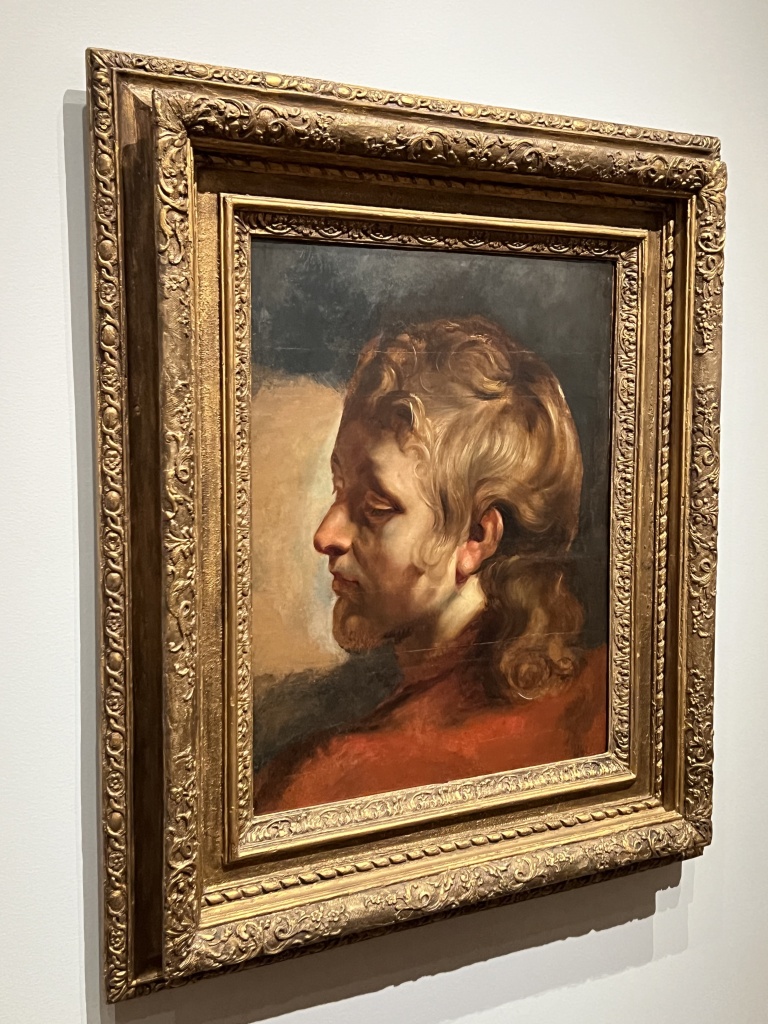
A specific painting which caught my eye was the “Study for Head of Saint John the Evangelist” by Peter Paul Rubens. The fixed position of the head of St John in the over-the-shoulder state was significantly important in reshaping religious artworks and promoting not only Catholic religions, but most religions in general. The Baroque painting was made of oil on wood and was given bright colors and sharp contrasts. His paintings in general gave a sense of passion and love, because of the way they were made and because it is depicting a somewhat religious figure, praised by many in Christianity.

Another painting which also grasped my attention was the “Nympheas, Water Lilies” by Claude Monet. This impressionist attempted to paint a moment in time, his water lilies. During his lifetime, he created about 250 paintings with this style of art. Extremely peculiar, from close distance it is blurry and seems to be abstract, yet as you walk backwards you start to get the picture intended. This type of art is tremendously creative and immersive. It also has a strong sense of passion and love, as the artist focuses all his works on his water garden in Giverny, which makes it personal and intimate. I found this style of painting truly remarkable and in turn sparked my interest in such. Similar artworks like this will definitely be portrayed in my future house one day.
To conclude, the Norton Museum has a great collection of art. Most being from the European medieval era, others not so much. Trips through museums like this enhance the perception one has towards artworks. After it, I found myself motivated to work on my own pieces, knowing a bit more and seeing a bit more from a range of artists made it easier for me to implement my own ideas.
Key Biscayne as Text
“A lighthouse of dreams” by Mariano S. Mendez Perez of FIU at Key Biscayne

When talking about Miami’s most interesting locations to visit, one must mention “el farito”. The lighthouse, located in Bill Baggs Park in South Florida, is the oldest standing structure in Miami Dade County. It has been destroyed and rebuilt numerous times, and so it has considerable history. Its original purpose was to protect ships from crashing into the coastal reefs, which was extremely common at that time.
The Bill Baggs Park in general is a great place to visit as it offers great views and a nice beach to swim in. It is now a nice spot to enjoy with your family and friends, however, it was not always like that. The lighthouse in specific was built during a time of conflict, “the Seminole War”. On July, 1836, Indian Seminoles attacked the structure, heavily damaging it in the process. A man named John W. B Thompson was able to survive and successfully defend the tower, but sadly his slave Aaron Carter did not. After those chains of events, a man named Bill Baggs convinced the owners of the land to sell it to the government, and so he did. This is why the location is now called after his name, he was the reason as to why we can go and visit the place.
Even though “el farito” is not the main beach I go to with friends, since it is not as local as the other ones, it has a touch of uniqueness that makes it such a cool beach. For one, the lighthouse right next to the water gives it such a cinematic view, unmatched by other places. Our classmates and I were fortune enough to be let inside the lighthouse and be able to take a peek at the top of it. It was spectacular, although tremendously windy that day for some reason, which degraded the whole experience a tiny bit, the view was so refreshing. One could see the beach, the park vegetation, and the city by just going around the lighthouse or just turning our heads. I was able to capture some truly amazing photography that really portrays our point of view. While I have been to Bill Baggs Park before, I have never been inside the lighthouse, it is something I can now check off my checklist.

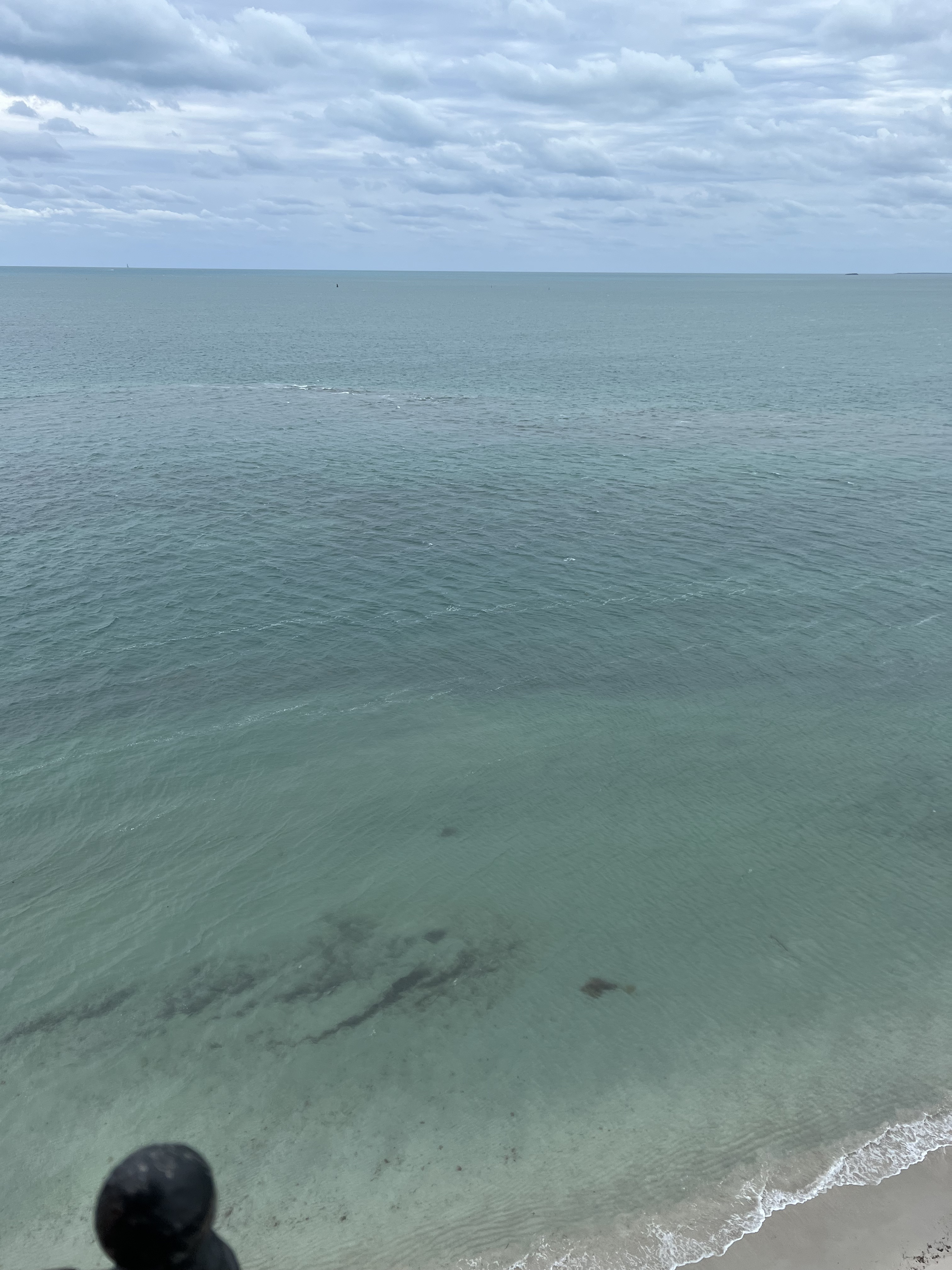
Photos by Mariano S. Mendez Perez / CC BY 4.0
Subsequently to going inside “el farito”, the class continued to the second phase, as we began to clean up the place. Using machete-like tools, we productively cut off any branches or leaves which were getting out of control. After it was all done, park rangers took care of the heavier debris.
Overall, the Bill Baggs Cape Florida Park in general is and has always been an amazing site to visit. Now knowing all the history behind it makes it so much more intriguing. Knowing that there was a war where I walked is chilling and immersive, it only adds cool factor points to the whole experience.
Wynwood as Text
“An unspecific Collection” By Mariano S. Mendez Perez of FIU at Wynwood
As our class arrived and consolidated on the main entrance of the Margulies warehouse, I knew from the beginning it was going to be an insightful experience. Our professor then presented us to Martin Margulies, a pronounced collector and real estate businessman. A knowledgeable old man, he possesses a large collection of over 5,000 pieces of art, ranging from contemporary art to photography. He took time out of his schedule to come present his collection to us, an admirable doing and one I am thankful of.

One of the first pieces of artwork he presented was the “Unfired Clay Torso” by Mark Manders. This sculpture is quite captivating, while the looks perceive that of a clay or ceramic figure, it is actually bronze. However, the thing I find the most interesting is the meaning behind the object, while some parts are shiny and well detailed, others seem brittle or destroyed. The whole structure has parts of art history from different periods in time. To the normal eye, the figure is a stunning clay figure, to the trained eye, and with a bit of backstory, one is hit with the hidden reality.

Another wonderful work of art in the Margulies Collection is Kiefer’s “Secret of the Ferns”. The small room-like constructions are meant to depict the hardships of the Jewish during the infamous Nazi Germany dehumanizing acts in World War two. It has a dark connotation and feeling to it, it lacks color and seems quite ruined or falling apart. Next to it there is 48 pictures of actual ferns. The artist believes ferns contain secret knowledge that follow a death principle; the whole idea in general is quite powerful. The structures weighted several tens of thousands of pounds, and so it needed special machinery to be brought into the warehouse. This all shows how much love Martin Margulies has for his collection of art.

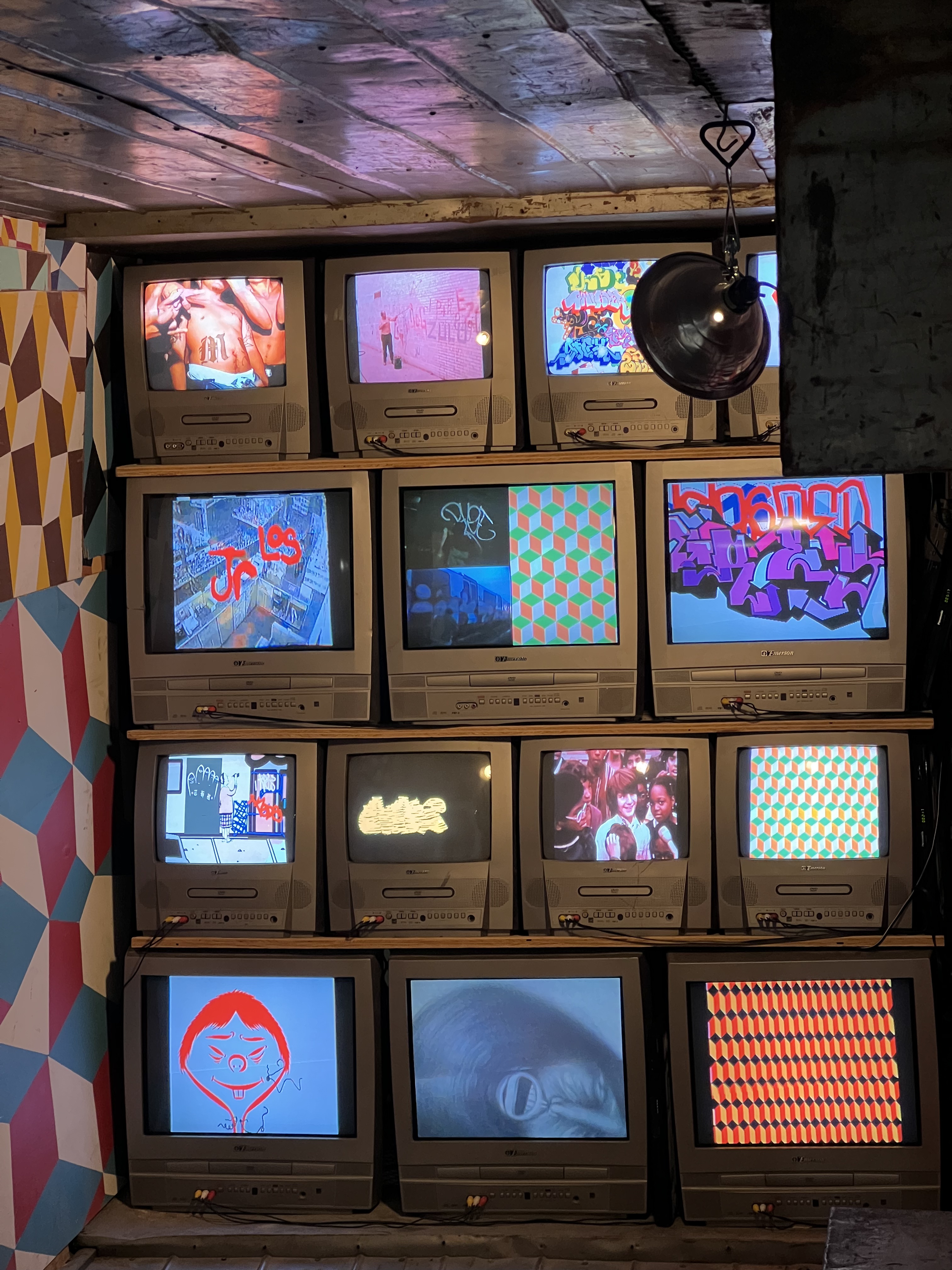
Photos by Mariano S. Mendez Perez / CC BY 4.0
Lastly, Barry Mcgee’s “truck installations with TVs” is such a cool concept to come up with. The artwork is basically a van, full of graffities, with multiple TVs inside of it. Is that not genuine? Graffiti was and is still used often as a form of expression in the streets. Usually as a way to get a message out to whoever the graffiti is intended to, the van marks an important change in Graffiti’s history, as it switched from a street thing to an institutional thing, being portrayed in museums, etc. Personally, to me, Mr. Mcgee’s truck is not just graffiti being displayed on a van, but the whole idea of the van with the turned on Tvs paired with the drawings that absolutely blew my mind, it takes much creativity to come up with that type of art.
As the live lecture of the Margulies collection came to a halt, Mr. Margulies explained the importance of the subconscious mind and how it can change our life. Personally, being exposed to more art has made me see so many different ideas, the ideas of those artists and what they are trying to portray, it is completely fascinating to me.
Chosen Neighborhood as Text
“A Miami Delight” by Mariano S. Mendez Perez of FIU at Miami Beach

Ever since I was a small child, I have had a passion for the ocean. I went to multiple Cuban beaches, and whilst they are still the best, in my opinion, Miami Beach is a close second for me.
Because of my love for the water, I participated in my old high school swimming club. I was extremely fast, beating the captain and numerous other prolific individuals. All that swimming has made me a bigger beach goer than most normal people. With that being said, now in the present day, I always see myself going to the local beach with some buddies to hang around. I love Miami Beach mostly because it is super local and near, it is also quite a decent beach so that is a plus.
The unmatched detail when comparing Miami Beach to the Cuban Beaches is that I can also go to a nearby hotel and stay the night, or buy whichever treat or drink I like from a local market if I really wanted to; Cuba lacks this for obvious reasons, its regime and whole system is a complete mess, but I will not get into that.
Another reason as to why I love Miami Beach is because of its racial mixture. One can see all types of ethnicities when walking by, not just Cuban Americans, but other Hispanics and Europeans as well. This makes the place have a positive atmosphere to it, as it is often full of visitors just having a good time and enjoying the warm weather and the beach.
As a long time enjoyer of the place, I know not to get caught up spending in restaurants or hotels, or anything in general. The location is fairly expensive since it is always a high demand place, fully packed on most occasions. Even parking is somewhat challenging or costly, that is why I tend to go with a large group of friends instead of each going on our own.
The decorative buildings in Ocean Drive feature an Art Deco style which definitely draws in numerous tourists. It has remained untouched pretty much since its construction, and it definitely makes up a significant portion of what Miami Beach is known for. Some people tend to go just to have a good time in the plentiful restaurants or to watch the beautiful buildings and the incredible scenery of what some consider the true Miami.
Sadly, there has been a recent Bill which if approved, could allow for the removal of some of these architectural marvels. The bills “SB1317” and “HB 1346” are made so that big corporations are legally allowed to own and destroy historic Art Deco buildings, or any building for that matter, even if classified as historic. This, personally, is a horrible idea, Ocean drive is somewhat the heart of Miami Beach. It must be preserved and retouched but never demolished.
Even if Miami Beach is not my all-time favorite beach I have ever been to, it holds close to my heart as a common spot I visit all the time. Since Miami always tends to have warm weather, it makes it perfect to go whenever one pleases, that paired with the fact that is relatively close by is complete delight to all Miamians.
Chicken Key as Text
“A necessary redo” by Mariano S. Mendez Perez of FIU at Chicken Key
As a highly energetic person, I find hikes and anything to do with physical activity a blast. That is why, when I heard that our classmates and I were going to head to Chicken Key for a second time to clean up, I was excited! With a crew of five highly talented individuals, we went around the island in search of contaminants and pollutants harming the beautiful ecosystem.
Sadly, the shores of the small island are always filled with debris. Due to the natural physics of the universe, all the trash left in the ocean slowly crawls back to the coasts, or sinks, or is eaten by animals that we in turn eat. This is partially why mercury ends up in our diet if we eat fish, a sad reality which must be combated at all costs.
Since this happens, it is imperative to stop polluting our oceans, but also to clean up uninhabited little islands like Chicken Key. It is always a good deed, and a fun one if paired with interesting individuals.
To no surprise, as our little crew of five came around the island, we found so much trash that if we really wanted to, we could have decorated a house, no kidding! We found parts of a couch which happened to weigh tons, some sort of plywood or plastic (also heavy), shoes, cans, etc. We really made and effort to try and fit all of it in our canoe, which was hard but, in the end, manageable. Even though we were working hard, our time was spent throwing jokes and puns, since this was the last class we were going to have.
As we continued in search of contaminants, we were alerted that there was a venomous water snake and that we should not roam around a specific part of the island. Apart from that, we spotted puffer fish and other kinds of fish but they were too fast to photograph. Also, while going around the island, I was able to see so much healthy mangroves and it reminded me of how great of a purpose cleaning up the island really is. During our semester, I learned mangroves are essential to us in South Florida, but to the little island of Chicken Key, important to its inhabitants, little crabs, spiders, birds, and snakes, amongst others. Mangroves help with soil erosion and with natural disasters like hurricanes, a natural phenomenon common in Florida, as it disrupts water currents and wind patterns.
Although the trip to Chicken Key is not a usual Miami in Miami class, as it lacks the live lecture which makes up part of the course experience, it is still complete fun. Kayaking, or in my case, canoeing there, is a healthy practice and a nice skill to have. Although that day in specific was quite windy, which made us push even harder, it did not diminish the experience. As a last class, I would say it was the perfect location, a memory for life.
Miami Final Reflection
“Memories” by Mariano S Mendez Perez of FIU
There is a saying that goes like “nothing good lasts forever”, and that is how I feel about this Miami in Miami class. As the course came to an end, I can now say that I know more about Miami than ever before. The amount of information I learned throughout the class is fantastic. Whether it was about a place’s history, or the place itself, this style of class in incredibly unique and effective. At the start of the fall semester, I still remember feeling a bit underwhelmed, being my first semester in FIU, I did not quite understand the class directions as I never took anything like it before. Because of this, I missed the first meeting where professor Bailly made his introduction. Although some might say it was not the ideal start, I later came to love this class for what it was, the search for the authentic Miami.
Personally, I had never really stepped out of my comfort zone when talking about going to new places. I knew Miami’s beaches like Dania Beach and South Beach, Downtown, and other common places. However, during the time of this class, we got to travel to the Everglades, to impoverished areas in Coconut Grove and Overtown, we also traveled to Chicken Key twice! Things I never really thought I would experience, especially not during my undergraduate studies. I definitely planned on this after I started working in my field later on, but not now. Though unexpected, I do not regret taking this class one bit. The live lecture style personally suits a class of this size, with only a small number of students, professor Bailly is able to get his points across without having to exert much effort. Also, because of the intimacy of being a smaller group, it was easier for everyone to make friends with one another.
Also, going to different museums like the Norton Museum in West Palm Beach or the Margulies collection in Wynwood, one got to reflect and perceive different artworks by a wide range of talented individuals. Pair that with awesome speakers and expositors like Martin Margulies and Mr. Bailly, amongst others, one gets to learn immersive knowledge, really interesting in nature. During our visit through various museums, I got to see a wide range of art, from Contemporary Art to Baroque to abstract pieces, I believe I saw it all, or came close to it. The illustration of ideas through paintings is as pure of an art as there is one. The creativity that some artists have like Barry Magee truck of TVs or the Monet Nympheas water lilies, every work possesses some sort of meaning, passion, and intention. A beautiful form of expression.
During our Everglades hike, we got to experience a side of nature we never get in touch with.
Actually getting in the water, and seeing wild animals and plants all around you is somewhat primitive, yet humbling. As one familiarizes with raw nature in real time, some of our perception changes. We live in a city heavily industrialized and modern, with abundant buildings and cars, yet we never really get to experience the world as it is. Most of us live within the city, never getting in contact with our plant. After the hike I felt a sense of awareness like never before. We must protect the very animals and plants within the Everglades, as they in turn protect and aid us.
The culmination of the class occurred in Chicken Key, and it could not be more perfect. Knowing it was the last class, our classmates and I had a blast going around the small island in search for debris. In the end, we were able to get incredible amounts of trash, helping the ecosystem thrive. I can now say I know Miami better than ever before, with different perspectives in life as a whole. All thanks to our great instructor Mr. Bailly and the Miami in Miami Honors class!







